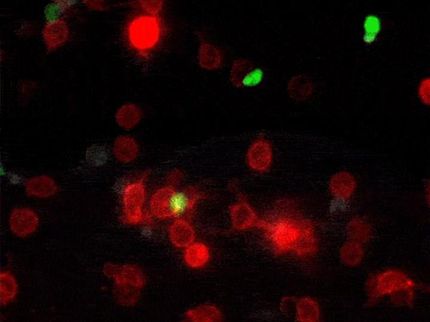Messengers from gut to brain
Seen for the first time: T cells traveling from the gut and skin to the central nervous system
Scientists have long been aware of a link between the gut microbiome and the central nervous system (CNS). Until now, however, the immune cells that move from the gut into the CNS and thus the brain had not been identified. A team of researchers in Munich has now succeeded in using violet light to make these migrating T cells visible for the first time. This opens up avenues for developing new treatment options for diseases such as multiple sclerosis (MS) and cancer.

Thomas Korn is a professor for Experimental Neuroimmunology at TUM.
Magdalena Jooss / TUM
The link between the gut microbiome and the CNS, known as the gut/brain axis (GBA), is believed to be responsible for many things: a person’s body weight, autoimmune diseases, depression, mental illnesses and Alzheimer’s disease. Researchers at the Technical University of Munich (TUM) and LMU University Hospital Munich have now succeeded in making this connection visible for the first time. This is cause for hope – for those suffering from MS, for example. It may offer ways to adapt treatments, and T cells could perhaps be modified before reaching the brain.
Immune cell migration in MS
The immune system is affected by environmental factors – also in the central nervous system in case of MS patients. This autoimmune disease is subject to repeated flare-ups, experienced by patients as the improvement or worsening of their condition. T cells collect information and, in MS patients, carry it to the central nervous system (in the brain or spinal cord) where an immune response is triggered. Until now, however, it was long uncertain how and from where the T cells were traveling to the CNS.
Using violet light to track marked T cells
The team working with Thomas Korn, a professor of experimental neuroimmunology at TUM, has developed a method for marking immune cells in mice using photoconvertible proteins. The T cells can then be made visible with violet light. The researchers successfully tested this method with the mouse model in lymph nodes, both in the gut and the skin. They were able to track the movement of the T cells from those locations into the central nervous systems.
Characteristics of T cells reveal their origin
T cells from the skin migrated into the gray and white matter of the CNS, while almost all T cells from the gut ended up in the white matter. For T cells in the brain, it was still possible to determine their origin. “What makes these insights so important is that they demonstrate for the first time that environmental influences impact the T cells in lymph nodes in the gut and the skin, which then carry this information into the distant organs,” says Prof. Thomas Korn. “The characteristics of the T cells are sufficiently stable for us to determine whether immune responses are influenced by skin or gut T cells,” adds LMU researcher Dr. Eduardo Beltrán, who performed the bioinformatic analyses in this study.
Starting point for future treatments
An important insight for MS patients: “If gut or skin cells were known to be the cause, the T cells could be treated at the source of the disease and predictions could be made on the progress of the chronic inflammation and autoimmune condition,” says first author Michael Hiltensperger. The results of the study could also mean a breakthrough for research on other autoimmune diseases or cancer.
Original publication
Other news from the department science

Get the analytics and lab tech industry in your inbox
By submitting this form you agree that LUMITOS AG will send you the newsletter(s) selected above by email. Your data will not be passed on to third parties. Your data will be stored and processed in accordance with our data protection regulations. LUMITOS may contact you by email for the purpose of advertising or market and opinion surveys. You can revoke your consent at any time without giving reasons to LUMITOS AG, Ernst-Augustin-Str. 2, 12489 Berlin, Germany or by e-mail at revoke@lumitos.com with effect for the future. In addition, each email contains a link to unsubscribe from the corresponding newsletter.


























































